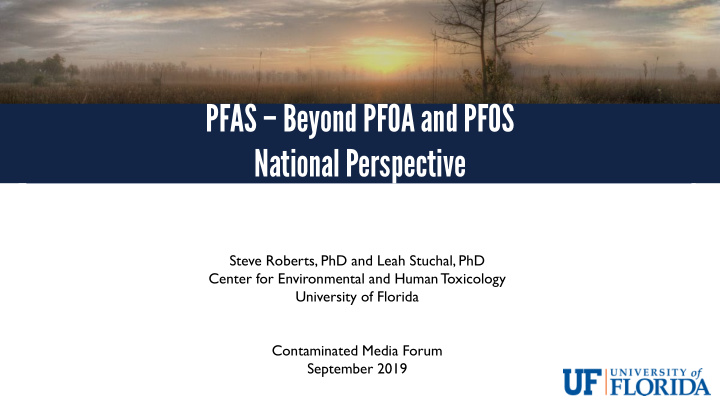



PFAS – Beyond PFOA and PFOS National Perspective Steve Roberts, PhD and Leah Stuchal, PhD Center for Environmental and Human T oxicology University of Florida Contaminated Media Forum September 2019
PFOA AND PFOS CHAOS PFOA PFOS U.S. EPA 70 70 California 14 13 Drinking Water Guidelines Connecticut 70 70 (in ppt) Massachusetts 20 20 Michigan 8 16 Minnesota 35 15 New Hampshire 12 15 New Jersey 14 13 New York 10 10 Vermont 20 20 2
WHY ARE THERE SO MANY DIFFERENCES? Development of risk-based drinking water guidelines involves several decisions regarding models and inputs requiring scientific judgment. This is particularly true for PFAS Critical effect/critical study Appropriate uncertainty factors Method for extrapolating doses from animals to humans Unlike most chemicals, there are blood concentration data for many of the toxicity studies Pharmacokinetic data available for a number of laboratory animal species/strains and for humans Uncertainty about some of the pharmacokinetic parameters and the correct concentration metric (average concentration, peak concentration, or something else) The appropriate receptor and associated exposure parameters (e.g., generic adult, pregnant woman, breastfed infant) 3
STATES WITH GUIDELINE VALUES FOR OTHER PFAS (PPT) PFNA PFHxS PFHpA PFDA PFBA PFHxA PFBS GenX Connecticut 70 70 70 Massachusetts 20 20 20 20 2000 Michigan 6 51 400,000 420 370 Minnesota 47 7000 2000 New Hampshire 11 18 New Jersey 13 North Carolina 140 Vermont 20 20 20 Adapted from Post presentation SETAC PFAS workshop August 2019 4
DEALING WITH EXPOSURE TO MULTIPLE PFAS Guideline Value (ppt) Sum of EPA 70 PFOA + PFOS Connecticut 70 PFOA + PFOS + PFNA + PFHxS + PFHpA Massachusetts 20 PFOA + PFOS + PFNA + PFHxS + PFHpA + PFDA Vermont 20 PFOA + PFOS + PFNA + PFHxS + PFHpA 5
WOULD A TEF APPROACH (LIKE DIOXIN) WORK FOR PFAS? The TEF (T oxic Equivalency Factor) approach is well established for mixtures of related compounds such as cancer effects from dioxin and polycyclic aromatic hydrocarbons. The concept is that these chemicals are closely related toxicologically as well as chemically, producing the same effects through the same mechanism, albeit with different potencies. The problems for PFAS: It is not clear whether they have a common critical effect There is little information on mechanism(s) of toxicity The number of chemicals of potential interest is extremely large (thousands) and chemically diverse 6
THE SCOPE OF THE PROBLEM • PFAS are numerous with diverse chemistry • There are many uses, and therefore many sources of exposure • Virtually everyone has PFAS in their blood • Some PFAS are being phased out, but are being replaced by other PFAS • Knowledge regarding potential health effects is limited to a relative handful of compounds 7 from Wang et al., ES&T 51:2508-2518, 2017
“WE’RE NOT GOING TO BE ABLE TO TEST OUR WAY OUT OF THIS” EPA and NTP are using a T ox21 approach for PFAS (see Patlewicz et al., EHP 2019) An initial library of 75 PFAS have been selected as priority for tiered toxicity and toxicokinetic testing, representing various categories of PFAS The 75 compounds are undergoing high throughput toxicity (HTT) testing: In vitro assays focused on endpoints such as hepatotoxicity, immunotoxicity, developmental toxicity, and assays to predict toxicokinetics These data will be used to support read-across The objective is to combine in vitro data with data on human exposure to develop a Biological Exposure Ratio (BER) to prioritize chemicals for in vivo testing. 8
Recommend
More recommend